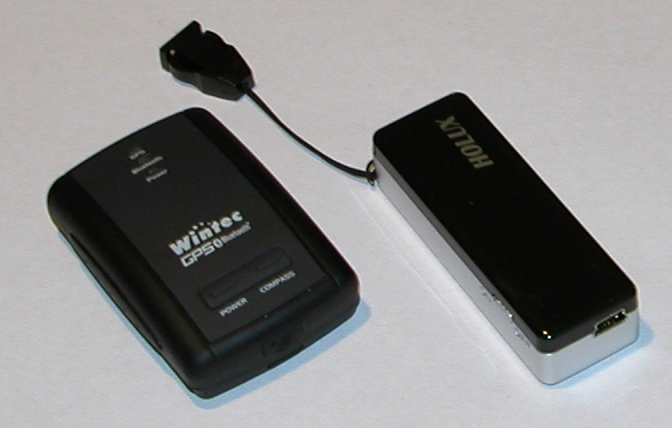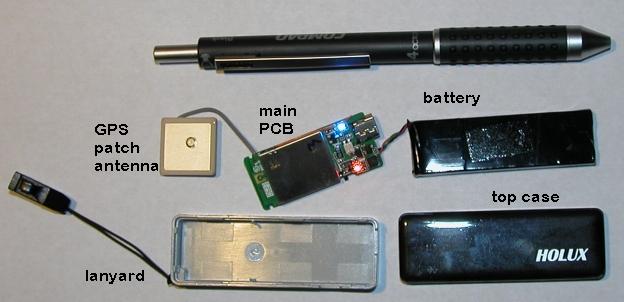The GPSlim240 Manufacturers Specs
The following specifications have been obtained from the Holux website www.holux.com:
Specifications
Tracks up to 20 satellites.*
Receiver: L1, C/A code.
Update rate: 1 HZ(max)
Antenna Type: Built in Patch Antenna.
Minimum signal tracked: -159dBm *
Dimension: 64 x 22 x 15 mm
Weight : < 35g
On/off switch: slide switcher
Lithium-ion battery lasts for more than 8 hours of use.
Operation Temperature: -10 0C to + 60 0C
Store Temperature: -20 0C to + 70 0C
Operation Humidity:5% to 95% No condensing
3 Led Function: Bluetooth , Navigation, Power
|
*) You can only see about 12 satellites. What they meant to say is "20 channels" so that you can receive multiple signals from the same satellite, particularly in urban canyon conditions.
What the specs don't say - this is a new SiRF III chipset - the Low Power version. And it has to be because the battery is rather small.
 Speaking of the battery - it looks like this is becoming the limiting factor in the design of the receivers. The WinTec WBT-100 that we reviewed earlier had the same feel to it - it was just a case around the battery, with a tiny PCB tucked into the case. Speaking of the battery - it looks like this is becoming the limiting factor in the design of the receivers. The WinTec WBT-100 that we reviewed earlier had the same feel to it - it was just a case around the battery, with a tiny PCB tucked into the case.
The Holux is a tad longer than the Wintec, but only half as wide. The height is about the same.
The battery on the GPSlim240 is not user replaceable. Well, not easily... It is not a standard Nokia battery, but rather an exotic stick with a PCB style connector.
Battery runtime is given as 8 hours. I was able to confirm that, my review unit regularly pulled 8 hours 20 minutes from the fully charged state to the time when the GPS circuitry switches off (Bluetooth continues for another 10 minutes, but that is rather pointless).
A look at the receiver - inside and outside
The battery is charged through a mini USB connector, either off a wall charger, or through a computer USB connection. (When you buy the receiver you'll get a cigarette lighter USB adapter and a USB-miniUSB cable included in the box.)
On the side you have the slide on/off switch (which means you could tuck this device away in the car somewhere - however that would not do the nice looks enough justice).
Opposite the power connector is the lanyard thingie - highly appreciated since the device's size somehow encourages it to slip through cracks and get lost unless you fasten it somewhere or carry it around your neck. The strap that is shown in the pictures is not included - that's my own!
The top of the case is clear black plastic. Looks very fashionable until you have the first finger print on it. Happy wiping... The status LEDs will shine through the black plastic. As always they are way too bright, and while I was dismantling the unit they got the usual treatment with a touch of black permanent marker. That helps a lot.

The ceramic GPS patch antenna is really tiny, only half the size of the normally used component. The receiver sensitivity didn't seem to suffer from that one single bit.
The stick design might have warranted a different antenna type (a quad helix like in the TomTom MKII receiver) but the patch antenna is good enough to get a position fix even when the receiver is dangling on the lanyard, with the antenna pointed horizontally - 90 degrees to where it should point to.
 The bottom of the unit sports two little rubber feet, but these are rather useless. Due to the low weight of the receiver the unit will happily slide over pretty much any surface. Better tuck it in somewhere. The bottom of the unit sports two little rubber feet, but these are rather useless. Due to the low weight of the receiver the unit will happily slide over pretty much any surface. Better tuck it in somewhere.
The USB connector also serves as a data link for the scenario when you want to use the receiver with a notebook through USB. However, you need a special USB cable (the one with the hump) and you need to install the appropriate driver on the notebook.
In operation
Using the receiver is very simple. Like any other Bluetooth receiver you need to discover it from your Pocket PC, Smartphone, or Notebook. When asked for a PIN code, use "0000". Then you connect to the serial port offered by the device. That's it.
The orange GPS LED will be on steadily if the device doesn't have a fix, and will blink when a fix is available (as usual we would have wished the signaling would be the other way round)
When the battery starts getting low the middle LED will come on with a weak red light that becomes stronger and stronger the more the battery nears depletion. The first red light will come on a good half hour before the end, so you should have plenty of time to decide if you need to save the last bit of battery for later, or if you want to put the device into the charger.

Many Pocket PCs and Smartphones nowadays come with the same mini USB connector, and thanks to the small size of the unit it will fit in most of the powered mounts. An example is shown here (the A701 Proclip/Brodit mount that we will review soon). Looks like the mini USB connector is becoming the new iPAQ connector that was ubiquitous two years ago.
|